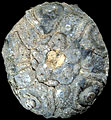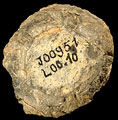The Echinoid Directory
Reboulicidaris Vadet & Nicolleau, 2005, p. 7
| Diagnostic Features |
|
|---|---|
| Distribution | Pliensbachian (Domerian), Lower Jurassic, Morocco |
| Name gender | feminine |
| Type | Reboulicidaris rebouli Vadet & Nicolleau, 2005, p. 7 [=Firmacidaris precincta Lambert, 1937, p. 47 (pars), pl. 4, figs 1 and 2 only], by original designation |
| Species Included | Only the type species |
| Classification and/or Status | Cidaroidea, Cidaroida, Psychcidaridae Subjective junior synonym of Roseicidaris |
| Remarks | This test was first described by Lambert (1937) under the name Firmacidaris precincta, a taxon based on a spine. As discussed by Vadet & Nicolleau (2005), Lambert was wrong to associate this test with the spines. In test and spine morphology it conforms to Roseicidaris only it is a much larger species. Lambert, J. 1937. Echinides fossiles du Maroc. Notes et Memoires du Service des mines et de la Carte geologique Maroc 39, 39-109, pls 1-4. Vadet, A. & Nicolleau, P. 2005. Les oursins Domerien de la region de Rich (Maroc). Annales de las Societe d’Histoire Naturelle du Boulonnais 5(1), 1-36. |






